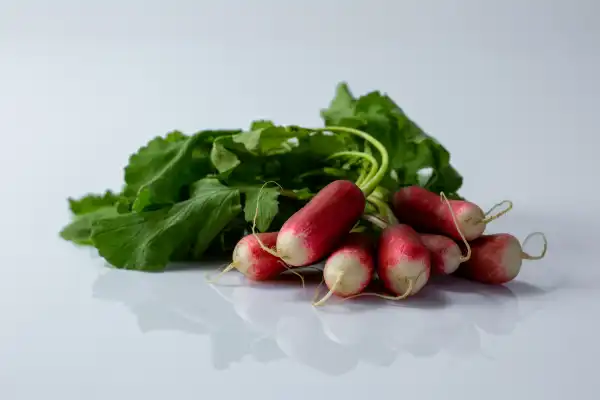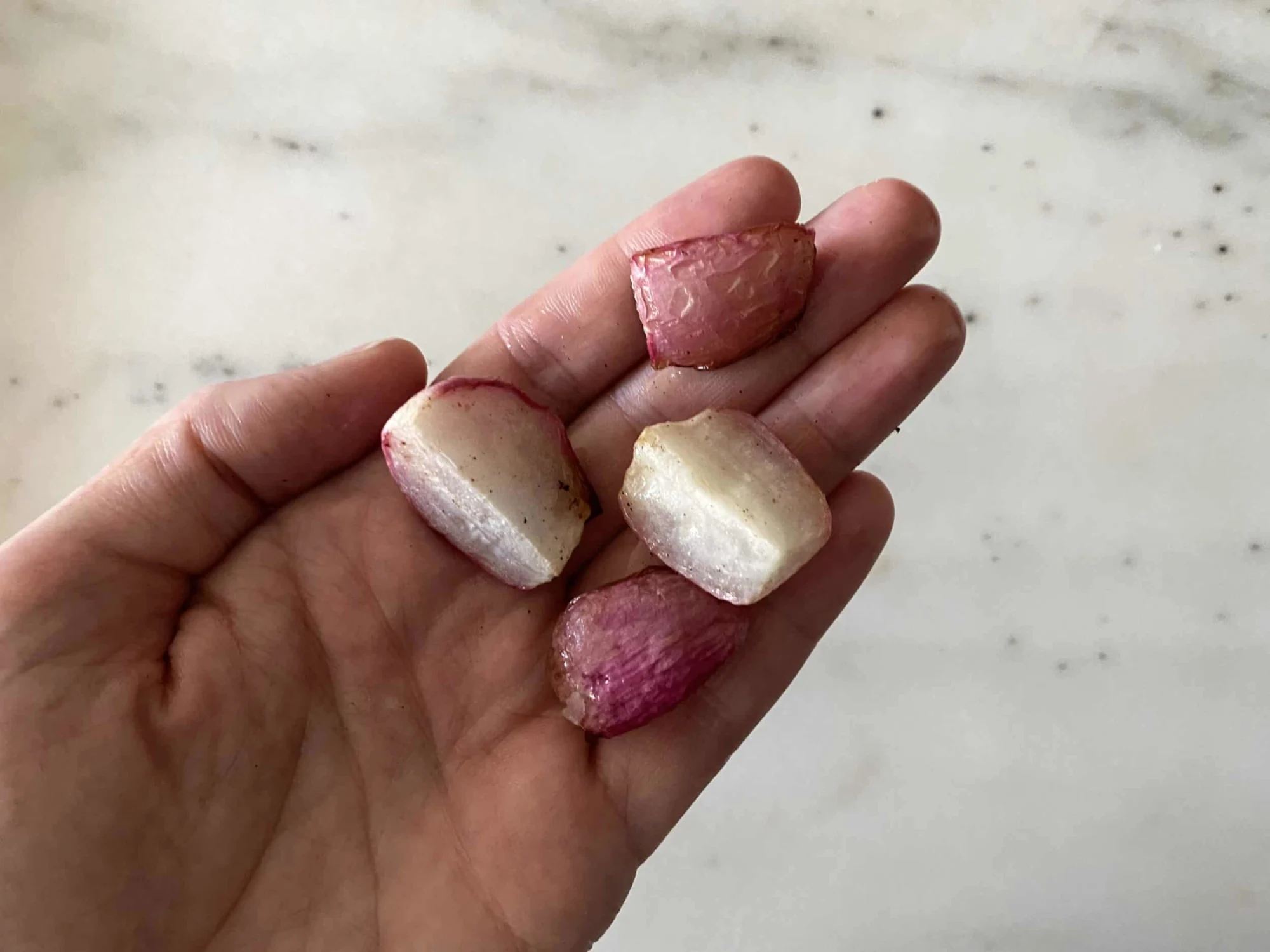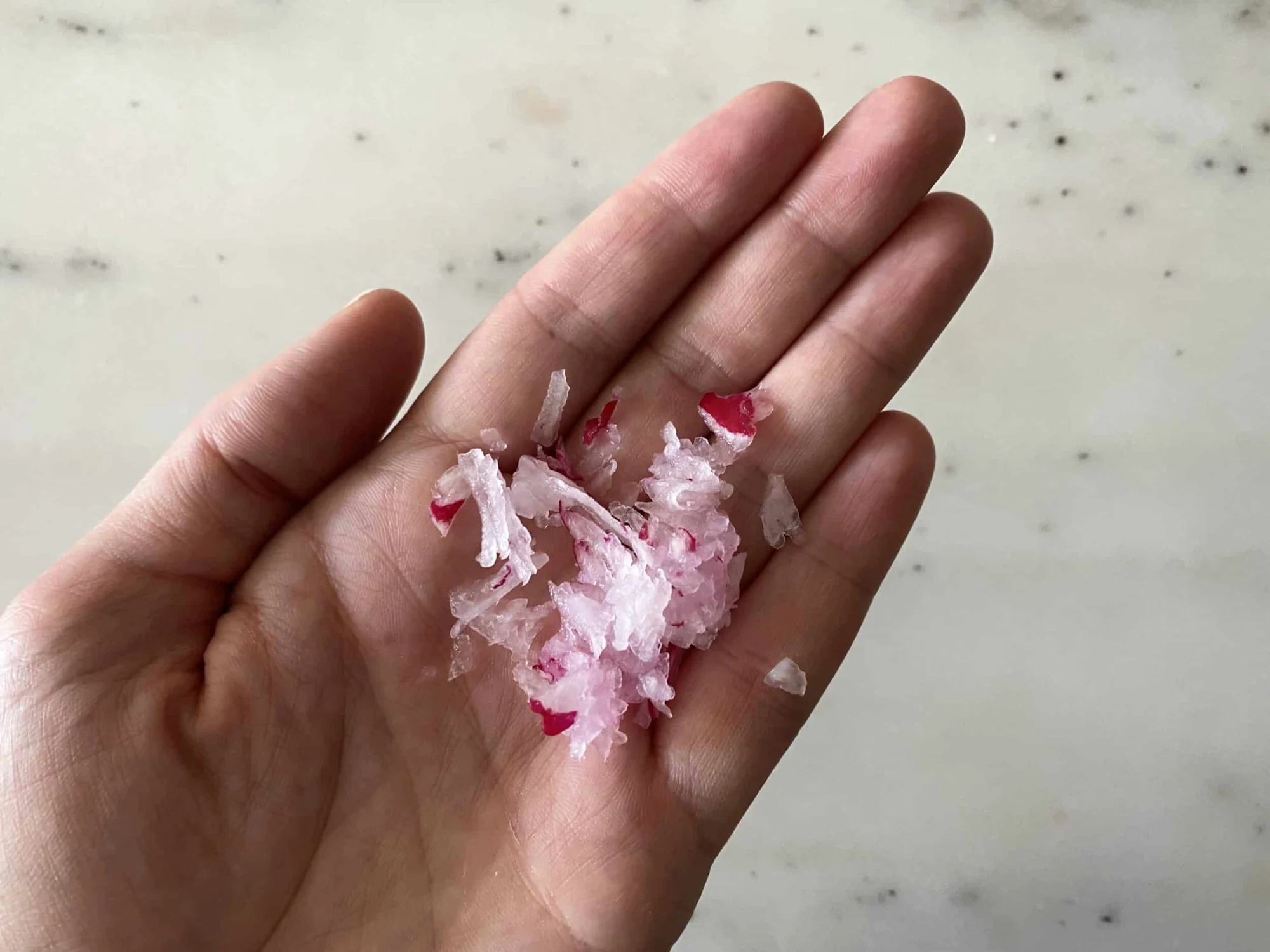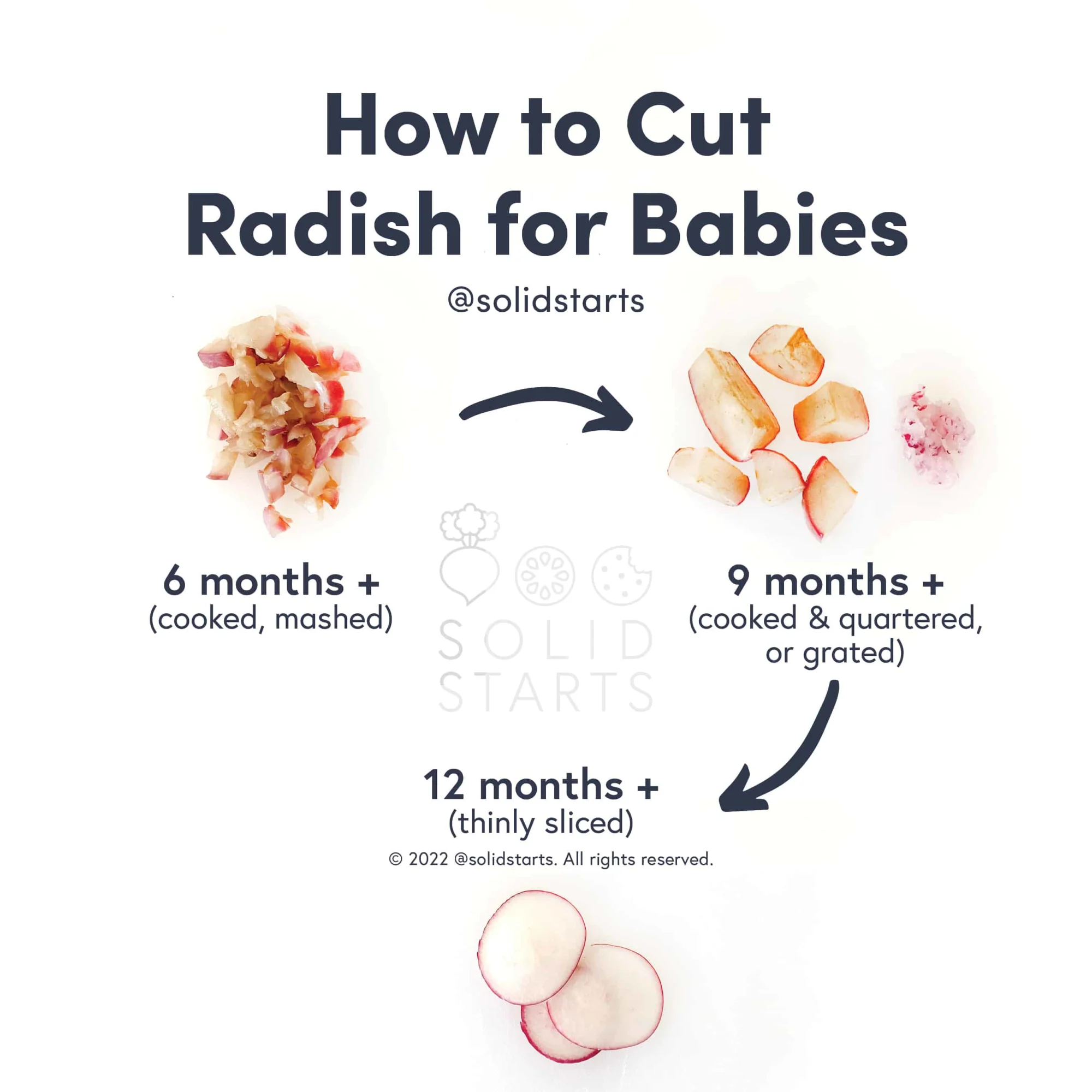Acceda a la base de datos First Foods® en Solid Starts App.
Leer másRábano
Vegetal
Sugerencia de edades
6 meses
Alto contenido de hierro
No
Alérgeno común
No

When can babies eat radishes?
¡Lo sentimos, esta página aún no está disponible en español! Estamos trabajando tan rápido como podemos para traducir todo nuestro contenido, gracias por tu paciencia y apoyo.
Radish may be introduced as soon as baby is ready to start solids, which is generally around 6 months old.
How do you prepare radishes for babies with baby-led weaning?
Cada bebé se desarrolla a su propio ritmo, y las sugerencias que ofrecemos sobre cómo cortar o preparar determinados alimentos son generalizaciones para una amplia audiencia.
6 to 8 months old:
Cook the radish until it is very soft and pierceable with a fork, then mash and serve in a bowl for baby to scoop with their hands. You can also introduce baby to radish’s spicy flavor by offering a small pinch of grated raw radish or minced pickled radish on top of baby’s food. Radish leaves are edible, too—if you’d like to serve them, finely chop the cooked greens and stir them into the mashed root or another soft, scoopable food like yogurt.
9 to 12 months old:
At this age, babies develop the pincer grasp (where the thumb and forefinger meet), which enables them to pick up smaller pieces of food. When you see signs of this development, try moving down in size by offering quartered or thin slices of cooked, soft radish. You can also offer small amounts of grated raw radish, as well as cooked, chopped radish greens.
12 months and up:
Offer thinly sliced or grated raw radish, or continue to offer bite-sized pieces of cooked radish and try serving alongside a fork or spoon to encourage utensil practice. If the child is not interested in using a utensil, don’t worry: using utensils can be exhausting for new eaters, and many children toggle back and forth between feeding themselves with their fingers and utensils. Consistent and accurate utensil use will come in due time, probably between 18 and 24 months of age.


Get hundreds of meal ideas with our Meal & Recipe Ideas Kit.
¡Lo sentimos, esta página aún no está disponible en español! Estamos trabajando tan rápido como podemos para traducir todo nuestro contenido, gracias por tu paciencia y apoyo.
Videos
Are radishes a common choking hazard for babies?
Yes. Raw, hard vegetables like radishes are choking hazards. To minimize the risk, cook radish roots until soft, then mash, or grate raw radish before serving. As always, make sure you create a safe eating environment and stay within an arm’s reach of baby during meals. For more information on choking, visit our sections on gagging and choking and familiarize yourself with the list of common choking hazards.
Are radishes a common allergen?
No. Allergies to radishes are uncommon, but have been reported. Radishes are part of the cruciferous vegetable family and individuals who are allergic or sensitive to other members of this plant family, such as mustard greens and broccoli, could theoretically be sensitive to radishes as well.
Individuals with Oral Allergy Syndrome (also known as pollen food allergy syndrome), and in particular those with sensitivities to mugwort pollen, may also be sensitive to cruciferous vegetables like radishes. Oral Allergy Syndrome typically results in short-lived itching, tingling, or burning in the mouth and is unlikely to result in a dangerous reaction. Cooking radishes can help minimize the reaction.
As you would when introducing any new food, start by offering a small quantity for the first few servings. If there is no adverse reaction, gradually increase the quantity over future meals.
Are radishes healthy for babies?
Yes. Though radishes are not as nutrient-rich as some other vegetables, they still offer plenty of benefits, including potassium, a bit of vitamin C, B vitamins, folate, and calcium. All radishes offer plenty of phytonutrients, while red and purple radish varieties have extra antioxidants.
Interestingly, pickled (fermented) radishes, on their own or in combination with other foods such as in kimchi, help to support baby’s developing gut microbiome. Fermented vegetables and other probiotic-rich foods introduce friendly bacteria to baby’s digestive system, which support brain development, hormone function, and immune regulation. However, pickled radishes and kimchi can be high in sodium (in excess of baby’s needs). Therefore, rinse pickled radishes and kimchi under water to reduce sodium before offering to babies.
Radish leaves are also edible and packed with nutrients, including protein, fiber, vitamin C, and calcium, as well as other beneficial plant compounds like quercetin and antioxidants.
Can radishes help babies poop?
Radishes offer good amounts of fiber (particularly lignin, a type of insoluble fiber), glucosinolates, and phenolic compounds – together, these contribute to overall digestive health and bowel regularity. Note that pooping patterns can vary significantly from child to child. Be sure to talk to your pediatric healthcare provider if you have concerns about baby’s pooping and digestive function.
Where do radishes come from?
Radishes grow worldwide in myriad colors, shapes, and sizes. While the vegetable's origin remains a mystery, studies suggest the plant may have first sprouted in Asia, where wild radishes can still be foraged and cultivated varieties are part of everyday cooking. Across the continent, one popular variety is the daikon radish (also called mooli), which is used in breads like luóbo gāo and paratha, pickles like do chua and takuan, and stews like mullangi sambar and sinigang. Other common types worldwide include the snowy white mu radish used in kimchi, the two-toned breakfast radish paired with bread and butter, and colorful globe-shaped radishes that adorn tacos. Like kohlrabi, turnip, and other brassicas, all parts of the radish plant are edible, including its nutrient-rich greens.
What are recipe ideas for cooking with radishes?
Radishes are used in cuisines all over the world, which means you have plenty of options. Try combining radish, avocado, and lime juice to make a simple salsa fresca that tastes delicious on breakfast tacos, grilled fish, or stewed meats recipes with Mexican roots. Toss radish, garlic, and scallion with vinegar and pepper to make musaengchae, a spicy side dish in Korean households and restaurants alike. Simmer radish and other vegetables in a flavorful stock like oden, a nourishing one-pot dish in Japan. Get inspiration from Indian cooks and stew radish greens in moong dal or season shredded radish with spices. Want to keep it simple for baby? Finish roasted radishes with butter—a nod to the classic flavor pairing in France.
★Tip: When stored properly, such as in a paper bag, radish roots can last 10-14 days in the fridge. The greens have a shorter lifespan and are best used in a couple of days.
Nuestro equipo
Escrito por
Consejos de expertos directo a tu bandeja de entrada
¡Suscríbete y recibe correos semanales con recetas, consejos y más!
Copyright © 2025 • Solid Starts Inc







